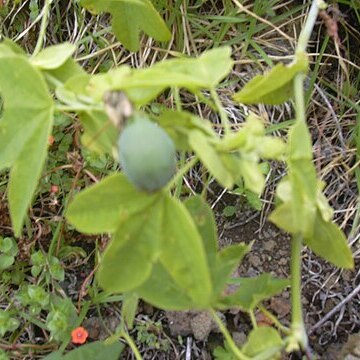Perennial vine to c. 8 m long, with simple axillary tendrils, glabrous. Stem terete, striate, slender. Stipules ovate to oblong, 1–4 cm long, 0.5–2.5 cm wide. Leaves alternate, 3-lobed for ½ to ¾ of length; lobes widest near base or middle, oblong, rounded or obtuse, central lobe with a single main vein, lateral lobes each with 2 main veins; lamina 4–10 (–12) cm long, 4–12 (–15) cm wide, pale bluish green above, glaucous beneath, with glands on the margins of the sinuses, base cordate, often subpeltate, margin entire; petiole 3–6 cm long, with 2–4 (–6) glands (0.5–1 mm diam.) near middle. Flowers bisexual, borne singly or rarely in pairs in leaf axils, 4–6 cm diam.; pedicels 3–6 cm long; bracts 3, ovate-oblong, 1–1.5 cm long, 0.7–1 cm wide, glandular-serrulate near base, free. Sepals white adaxially, green abaxially, 2–3 cm long, keeled, terminating in a green awn 6–13 mm long. Petals white, 1.5–3 cm long. Corona of 5 series of filaments, white; outer 2 series 1–2 cm long; inner series 2–6 mm long. Operculum white, membranous, c. 2.5 mm long. Androgynophore straight, 10–12 mm long. Stamens 5. Styles 3. Fruit and ellipsoid or subglobose berry, 3.5–6 cm long, 2.5–4 cm wide, greenish yellow when mature. Seeds finely reticulate.
Rather slender climbers, glabrous throughout. Leaves shortly petiolate, basi-fixed, very broadly 3-lobed to about the middle, the 3 lobes subequal, rounded, with 2-3 pairs of inconspicuous serrulate glands in the sinuses, rounded to subcordate at the base, 4-9 cm. long, 5-12 cm. broad; petioles 2-6 cm. long, with 1 pair of in-conspicuous glands at about the middle; stipules conspicuously foliaceous, broadly ovate, 1-4 cm. long and about half as broad. Inflorescences solitary, bearing a single purple and white flower; peduncle 2-5 cm. long, jointed directly beneath the flower; bracts conspicuously involucrate, broadly ovate, about 1.0-1.5 cm. long and broad, abruptly acuminate, pale green somewhat tinged with rose. Flowers about 5-7 cm. in diameter; sepals oblong, about 3 cm. long, very con-spicuously corniculate; petals narrowly lanceolate, 2.0-2.5 cm. long; filaments of the corona in several series, the outermost about equaling the petals. Fruits sub-globose, 3-4 cm. in diameter.
A vine which climbs by tendrils. The leaves are simple and 6-8 cm long. They can have 3 blunt lobes. The upper side is bluish green while the underside is covered with a waxy bloom. There are 2-4 stalked glands along the leaf stalk. The flowers are white and have conspicuous bracts around the base. The fruit is 20-60 mm long. They hang singly or in pairs in the axils of leaves. The pulp ripens from white to yellow. The pulp has an unpleasant smell. There are many seeds. The pulp is edible.
Herbaceous creeper or climber, up to 5 m high. Bracts and bracteoles conspicuous, foliaceous, forming an involucre, entire or with a few minute gland teeth at base. Stipules 15-40 mm long, straight, entire, foliaceous. Leaves 3-lobed to halfway. Flowers white.
Stipules large, 1½-4cm, straight, entire; flowers 4-5 cm wide, white; sepals ½-1 cm horned; fruit 2½-4 cm ø, with thick pericarp.

